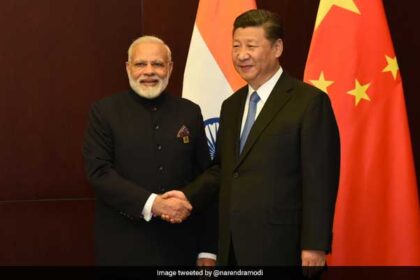Trumping Trump: India’s Strategic Toolkit in a Trumpian World
It would be tempting to dismiss President Trump’s economic warfare against India as an outlier. However, these attacks not only represent a corrosion in India-American relations but also warrant an urgent recalibration from India. As the world hurtles towards a new order, it is critical that India prepares for multiple disruptions, and is not lulled into complacency by wishful thinking.
Statecraft demands hard calculus, which necessitates objectivity. That is why it is crucial to contextualise President Trump’s, Senior Counsellor for Trade and Manufacturing Peter Navarro’s, Treasury Secretary Scott Bessent’s and a host of American official’s claims about India, which collectively speak to a larger structural shift.
They have alleged that India is bankrolling Russia’s war in Ukraine, profiteering by buying cheap Russian oil and exporting it at a premium, penalising American companies through exorbitant tariffs, and engaging in “strategic freeloading” by purchasing Russian weaponry. Even though these arguments are designed to elicit a response from India, they rest on a fundamentally flawed reading of the global economy and India’s long-standing foreign policy consensus.
Dissecting Trumpian arguments on India
Trumpian arguments not only vilify India as some kind of a global black-marketeer, but also sidestep facts. For example, India’s oil purchases were conducted transparently and with the active encouragement of both the United States of America (USA) and Europe. From the $85.9 billion worth of refined oil products exported from the Reliance refinery in Jamnagar between February 2023 to July 2025, 42% went to nations sanctioning Russia.
The US and Europe alone received a third of this, amounting to $ 19.7 billion). Additionally, 55% of Russian seaborne oil exports in June 2025 were transported on tankers from G-7 nations. In fact, the share of Russian oil being transported on oil tankers from G7 nations increased from 36% in January 2025 to 56% in June 2025.
In essence, the West wanted to maintain the fig-leaf of being tough on Russia, whilst continuing to benefit from affordable energy and essential goods. India was the only reliable partner with enough diplomatic standing on both sides.
India was able to do so because of its firm adherence to non-alignment and strident pursuit of strategic autonomy (a Nehruvian legacy that the Modi government has been compelled to follow, even though it has publicly vilified Nehruvian foreign policy principles for the last decade). It is because of this that global oil prices have remained relatively stable, without which they could have touched US$ 100 a barrel.
Objectively, President Trump’s tariffs on India have little to do with Russian oil. If Washington were genuinely intent on curbing Moscow’s energy exports, it would also have penalised China (which imported a record 109 million tonnes of oil from Russia, compared to India’s 88 million tonnes just in 2024. China thus accounts for 47% of Russian crude exports), or Turkey (which purchased 26% of Russian oil products) or Europe (which imported US$41.9 billion of goods from Russia in 2024, purchased 51% of Russian LNG exports and 36% of Russian pipeline gas).
At the same time, Trump would have acted against the 1750 odd US and European companies still operating out of Russia. Or against Exxon (America’s biggest oil company) which is reportedly engaged in back-channel talks with Rosneft, Russia’s state-owned energy giant. America would have also stopped importing fertilisers (it bought US $927 million worth in the first half 2025), metals (it bought US $1.3 billion worth just from January till June 2025) and other commodities from Russia.
According to the US Census Bureau, the US imported over US$ 3 billion worth of goods from Russia in just five months of 2025. If the logic of President Trump and Navarro’s arguments regarding India is extended to their policies, it could be argued that America is effectively bankrolling both sides of the Russia – Ukraine war.
In fact, America’s framing of India’s Russian oil trade as “funding war crimes” is insincere (and not just for the reasons outlined earlier). Interestingly, as per NaftoRynok, a Ukrainian oil market analytics firm, India accounted for 15.5% of Ukraine’s diesel imports in July 2025 (accounting for 2,700 tons per day). Clearly, adopting Trumpian logic, India is funding Kiev’s war machine (ironically by arming it with crude oil from Russia).
What is especially ironic is US’s moral hectoring has no basis, given it continues to enable Israel have a free-run in West Asia. By providing military, economic and diplomatic support to Israel, America is directly complicit in the devastating war in Gaza which has killed at least 60,000 people (including 20,000 children) in 21 months.
In the same vein, American tariffs on Indian goods have also been justified as retaliatory measures against India’s “Maharaja tariffs” (a racist characterisation of protectionist policies). This claim also needs to be objectively dissected. On one hand, Trump’s tariffs are essentially a camouflaged super tax on American companies and consumers (who will collectively absorb between 67-70% tariff costs according to Goldman Sachs).
Former Vice-President Mike Pence has publicly alleged that American tariffs are going to result in an US$ 3000 increase in the cost of daily goods for the average American household. On the other hand, while President Trump rails about India protecting its farmers and domestic industry (incidentally, another Nehruvian principle that the Modi government grudgingly follows in the national interest), US continues to pursue unilateralist technological, industrial, agricultural and militarist policies.
For example, while the US is pressurising India to give up protections for the agricultural sector, it itself has tariff-walls of 350% on tobacco products, 200% on dairy products and 120% on fruits. Even though these hostile trade policies could well come to naught (given a federal appeals court has recently ruled that President Trump lacked the legal authority to impose broad tariffs on nations), the fact remains that Trump’s actions are hypocritical, and so is the allegation that India is “getting in bed with authoritarians”, which is clearly a jibe at Russia and China.
This is more about circumscribing India’s foreign policy choices than any larger principles. This seems to be a classic case of the pot calling a kettle black given the US’ chequered history of aligning with dictators and authoritarians including Chile’s Pinochet, Argentina’s Batista, numerous Pakistani generals etc. and the fact that least 45 undemocratic nations host US military bases.
To misquote Oscar Wilde, America leads a double life – pretending to be good, while being wicked all this time. It would behoove the USA to remember that not only is the world not a unipolar one anymore, it also has no right to dictate who India (or any nation) trades with. Not is it doing India any favours given India is one the largest markets for American products, and Indian companies also create thousands of jobs by investing billions in America.
If anything, President Trump’s policies raise serious questions about whether America sees India as indispensable to its Indo-Pacific plans. This will invariably spark a domino effect. Not only is it going to strengthen India’s strategic autonomy resolve, it will also create incentives for Asia to invest within itself. But most importantly, it could push many nations into China’s arms (which is especially ironic given how disparagingly it deals with the sovereignty of multiple nations).
Lessons for India: A hard recalibration
President Trump’s continuous attacks on India’s strategic autonomy merit a strong and coordinated response from the nation. But while we present a unified case outside, we must critically assess our foreign policy choices in the last decade, and urgently redress them in the national interest. It is not enough to project an alternative India Way, but then flounder from crisis to crisis globally.
As things stand today, the Bharatiya Janta Party (BJP) government is just about managing this polycrisis by adhering to non-alignment (which it rechristened as multi-alignment, partly to avoid acknowledging its misplaced decade-long tirade against the Nehruvian doctrine). However these US-led disruptions will snowball into bigger shifts and hold multiple lessons for India.
Firstly, the advice to further entrench India with the US was based on the assumption that Washington would permanently see India as a democratic counter to China. This needs to be seriously re-examined. America has recently renewed its vows with Pakistan, prohibits advanced technology collaboration and American companies manufacturing in India, has put defence deals on ice and has possibly re-hyphenated India and Pakistan, by possibly laying the groundwork for a backdoor mediation channel (by making the next US ambassador to India a South and Central Asia czar).
America’s attacks on India has also forced the Modi government to make substantive concessions to China on the border to avoid a two-front problem. Given this, any conscientious patriot will inevitably ask whether there is even basic convergence of interests with America.
Secondly, PM Modi needs to permanently eschew his personalised-diplomacy. Despite propagating that his supposed friendship with global leaders, manufactured diaspora events, and click-bait acronyms had revolutionised India’s foreign policy, it is now painfully clear that none of these have worked. India’s relations with America, China, Pakistan, Nepal, Bangladesh, Canada etc. have deteriorated in the last decade.
In fact, Modi’s personalised diplomacy may well have had the exact opposite impact given President Trump might be singling India out (with 50% tariffs, efforts to internationalise Kashmir, rewarding Pakistan in myriad ways after Operation Sindoor etc.) because of a seeming snub by Modi during the last US elections (as also a refusal to accept Trump’s narrative on how the recent Pakistan war ended).
More than India’s foreign policy establishment (which continues to be highly professional), it is PM Modi who needs to understand that relationships are between nations, and not individual leaders. Conflating the two is to leave a nation’s strategic and economic interests dangerously vulnerable to the vagaries of individual dynamics.
Thirdly, the BJP government also needs to stop weaponising the Indian diaspora for its political and foreign policy goals (even though only a microscopic section of the total diaspora population allies itself with BJP). Both the BJP’s overseas units and right-wing diaspora units tried hard to ingratiate themselves to Republican legislators and lobbyists close to Trump in vain (with PM Modi’s rallies for President Trump being just the tip of the iceberg).
Yet, despite being part of the wealthiest diaspora group in the US (with an average yearly income of US$ 151,000), not one Indian-American group allied with PM Modi and BJP has either criticised President Trump, or rallied public support for India, or tried to reshape American policy on India. In fact, in allying themselves so umbilically to MAGA republicans, these small right-wing diaspora groups have alienated themselves from both moderate Republicans and the Democratic Party (who are defending India and publicly critiquing President Trump for destroying the India-US partnership painstakingly built over 25 years).
BJP’s ideological foreign policy adventurism has spectacularly backfired
Clearly, BJP’s ideological foreign policy adventurism (hawkishly lauded by sections of the Indian media which spins paid theatrics as foreign policy and the prime minister’s burgeoning popularity) has spectacularly backfired.
Finally, the Modi government needs to confront President Trump more aggressively in the pursuit of India’s core interests. The Modi government has complied twice with American diktats, ceasing oil imports from Iran and Venezuela. Likewise, the extension of waiver of the 11% import duty on import of cotton from the US till the end of 2025, while intended as a support mechanism for India’s textile industry, will have detrimental impacts on cotton producers in India.
Furthermore, PM Modi has been conspicuously silent on President Trump’s claims that he played a central role in the India-Pakistan ceasefire. While PM Modi’s cold shoulder may be an attempt to embarrass Trump publicly, it is also very likely that Trump’s officials will mistake PM Modi’s timidity for weakness, and keep escalating the ante. Perhaps it’s hard for him to be sensitive to this (given this is exactly what he does domestically with the opposition and civil society) but PM Modi needs to realise that bullies respond only to strength.
But this also means forging a coherent policy framework to safeguard India’s export sectors, by working consensually with all of India’s diverse stakeholders. The onus to take along every Indian stakeholder (including the states, opposition parties, businesspersons, associations/unions impacted by tariffs and foreign policy/military expert) so we can better confront the situation we face today is on the BJP government.
Unless the institutional memories, expertise and combined efforts of India’s vast reservoirs of talent are not constructively channelised to further India’s geo-economic goals, we will not realise our manifest destiny. And unless we work unitedly, the unprecedented challenges we face as the new world struggles to be born could overwhelm India. One can only pray that the Prime Minister prioritises the national interest over partisanship and dead habit.








